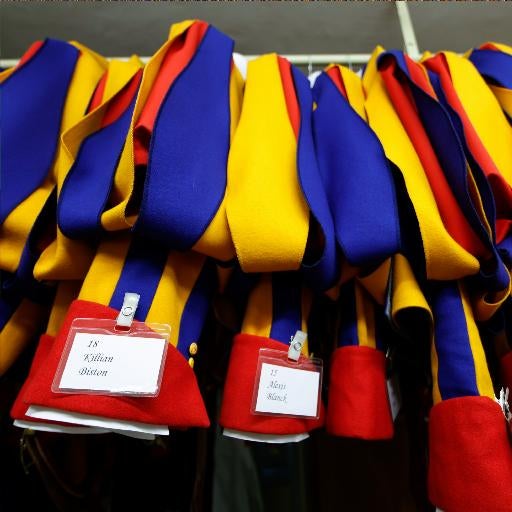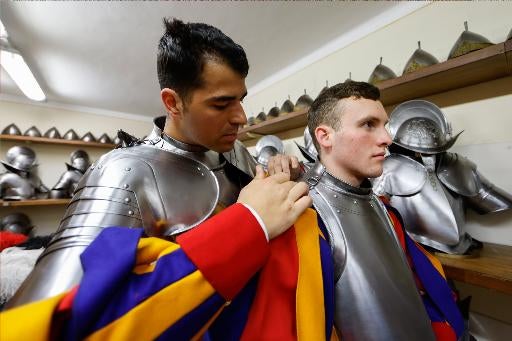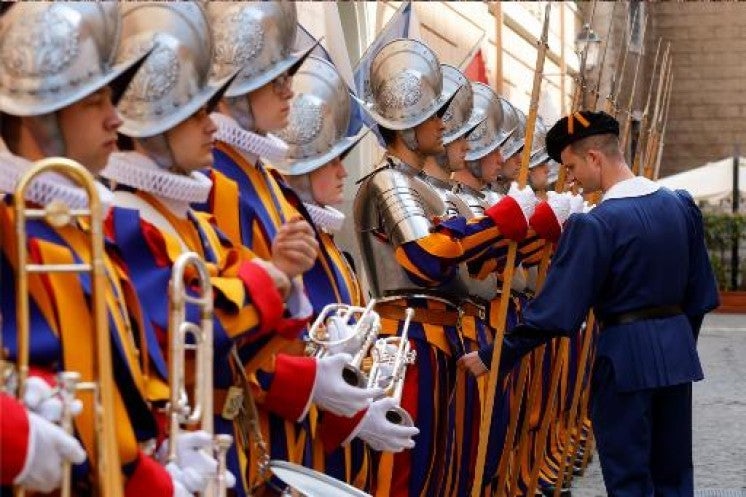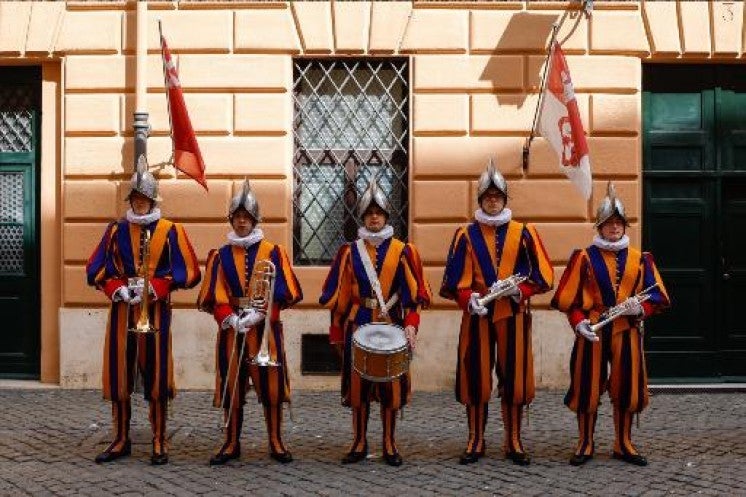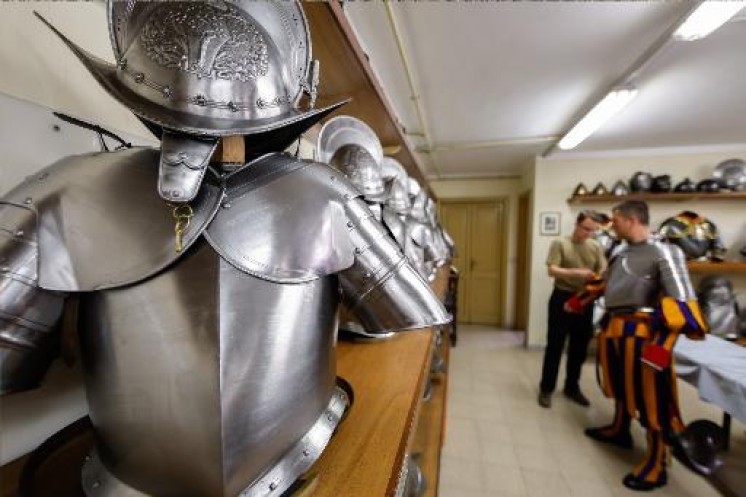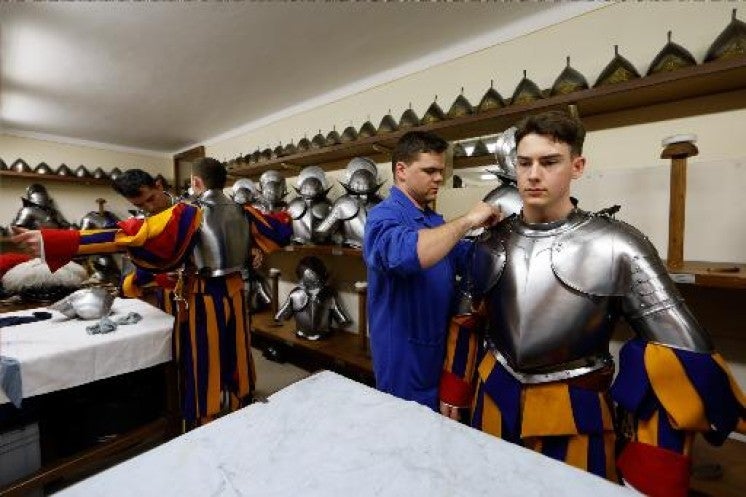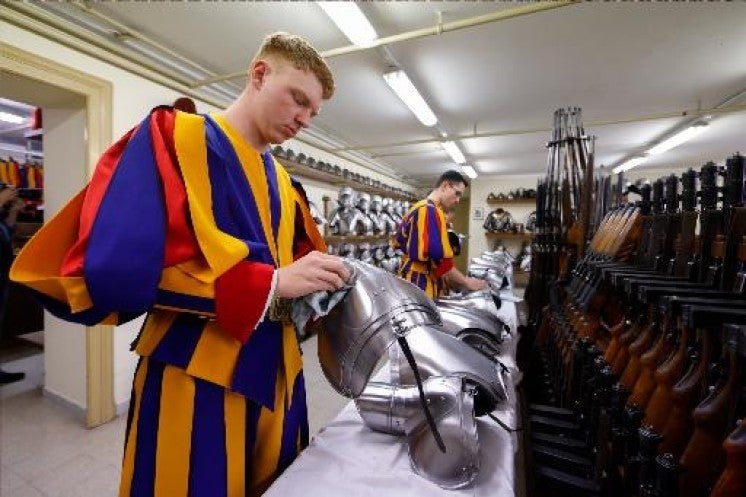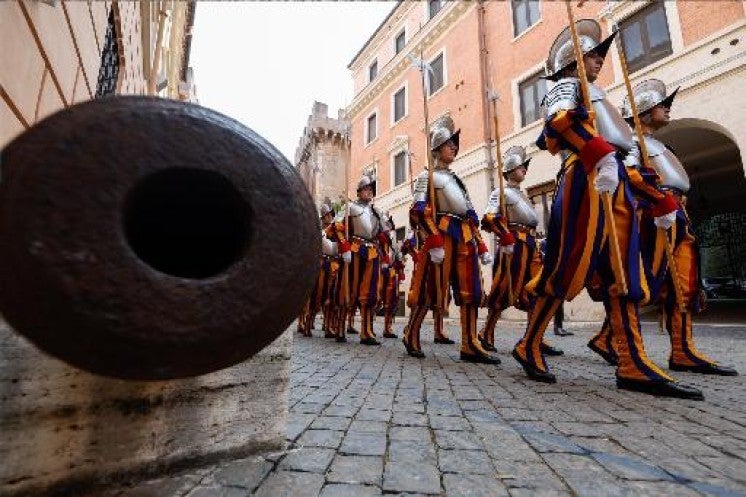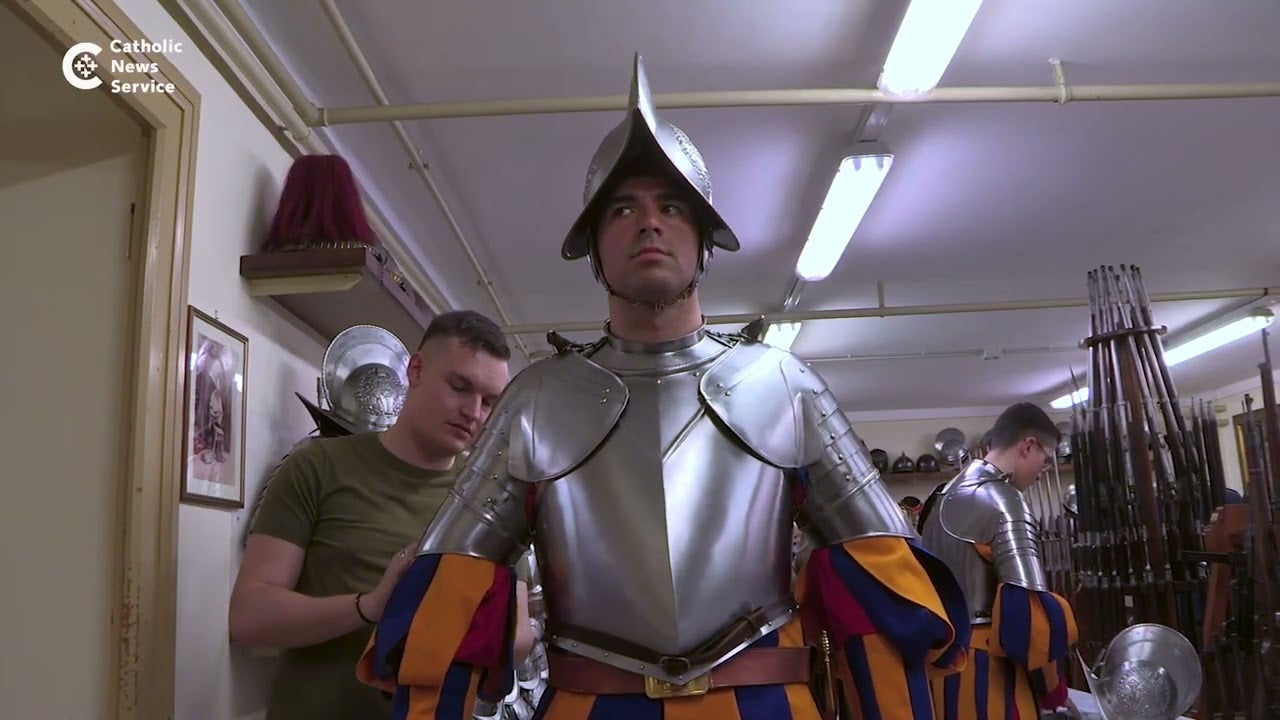Browsing News Entries
Mightier than the sword: Words are a Swiss Guard's best weapon
Posted on 05/3/2024 08:30 AM (USCCB News Releases)
VATICAN CITY (CNS) -- One of the oldest military corps in the world, the Pontifical Swiss Guard, has always armed itself with the best gear available in its 518 years of active service protecting the pope.
From 16th-century armaments of halberds, longswords and cannons to modern-day automatic assault rifles, Glock pistols, tasers and pepper spray, the guard's arsenal and tactical defense training have sought to be the most avant-garde to provide the best security for a high-profile, crowd-loving, globe-trotting leader.
While most tourists may only see the Swiss Guard as colorful and quaint -- standing guard at papal events and surveilling entrances into Vatican City State -- they are top-tier security specialists who actually find their most needed weapon is words.
"We have been trained in different combat techniques," as well as taken courses in psychology and situational assessment, said Corporal Eliah Cinotti, media officer of the Pontifical Swiss Guard.
But "nowadays you have to understand that the best weapon is talking. Until now we have had 100% (success) because we always manage to alleviate situations by talking," he told reporters April 30 in the courtyard behind the guards' barracks.
Thousands of people stream into St. Peter's Square, the basilica and the Paul VI Audience Hall for papal events and even more walk each day by the major entrances into the tiny city state where the guards are more at liberty to interact freely with the public.
While most passersby are inquisitive and curious, there has been "a significant increase" in the number of people experiencing some form of crisis, Corporal Cinotti said.
"There are more lonely people looking for comfort and maybe they see it in the Vatican," he said. There are also more individuals who might have some kind of psychological or mental disturbance "who come up to us and perhaps even ask for a word of comfort, a word of support."
While the 135 guards may work anywhere from six- to 12-hour days, he said the hardest part of the job is coming face-to-face, not with potential or actual troublemakers, but with those who are desperately seeking help.
Hardly distant sentinels, the guards, who are on average 22 years old, hear heart-wrenching stories from people.
Some people may have lost their job and have a large family to support, he said, or "there are people maybe who want to take their own life, and we have to stop this person from taking their life."
Others might say they absolutely must see the Holy Father, "and we cannot allow everyone into the Vatican, so we are always trying to have a solution," the corporal said. Most often people are "looking for a specific kind of help," and the Vatican is seen as a kind of "last resort."
"When we are serving the entrances, we are also there to be an ear that listens, too, and it is also part of our Christian formation," he said. The Swiss Guard is open only to Swiss male citizens who have graduated from high school, served in the Swiss Army, stand at least 5 feet 8 inches tall, are under 30 years of age and are Catholic.
"The pope always says that we are a calling card for the Vatican," he said, since the guards are such highly visible and relatively accessible public-facing figures. "But more importantly we are a bit like a messenger of the Gospel on the ground."
"We are also there to be Christians," which means trying to help others, he said. "We know what to do, but in the moment also sometimes a good word or even maybe putting yourself in the person's place helps. Listening especially helps."
The fact the Vatican is "a hot spot" for so many visitors is one thing that makes the job so unique, said Renato Peter, 24, who joined the Swiss Guard in September.
Most visitors are friendly, they might have a question or want a photo or information, he said, but that means it's also difficult to see which people might be trouble. While police officers typically head out to where a specific problem has been called in, for the Swiss Guard, "the problem comes to us" with no warning.
But working "on the border" at the entrances to Vatican City State is also one of the best parts of the job, he said, as it gives him a chance to meet people from all over the world.
Peter said he decided he wanted to be a Swiss Guard when he was 12 years old when his Diocese of St. Gallen organized a trip to the Vatican for a general audience in 2012. They visited the guards' barracks in the afternoon, "and then I said, 'Yeah, that's a cool job.'"
Peter, who will be officially sworn-in as a guard with 33 other young men May 6, said he thinks "it's really great" to serve Pope Francis who has been listed a number of times by Forbes magazine as one of the "Most Powerful People" in the world and is a "spiritual mentor" to 1.39 billion Catholics around the world.
The recruit likes the camaraderie and friendships he's made, but he is not a fan of Rome's heat, which can reach 107 degrees Fahrenheit or more. It's a job where sometimes "you don't do anything, but you sweat a lot."
Türkiye suspends all trade with Israel over Gaza war
Posted on 05/3/2024 06:02 AM ()
As the war in the Holy Land continues to cause great suffering, Türkiye has suspended all trade with Israel over its operation in Gaza.
Pope: 'All young people deserve equal job opportunities'
Posted on 05/3/2024 05:14 AM ()
Meeting with the National Vocational Training Confederation (CONFAP), Pope Francis encourages the Italian Catholic network to focus its attention on young people from disadvantaged backgrounds who are marginalized by the job market and feel rejected by society.
Pope: Education must form people, not offer impossible ideals
Posted on 05/3/2024 03:45 AM ()
Pope Francis meets with members of the Blanquerna Foundation from Barcelona, and urges Catholic universities to provide education that helps people form their minds and hearts, without seeking to create “illusory replicas of impossible ideals.”
News from the Orient – May 3, 2024
Posted on 05/3/2024 02:00 AM ()
In this week's news from the Eastern Churches, produced in collaboration with L'Œuvre d'Orient, Christians following the Julian calendar celebrate Palm Sunday, Cardinal Louis Sako marks his priestly jubilee, and St. Joseph Universiry in Beirut nears its 150th anniversary.
Spanish archbishop slams government’s obsession with the Catholic Church
Posted on 05/2/2024 22:50 PM (CNA Daily News)
 Oviedo Archbishop Jesús Sanz Montes accused the government of focusing "in a biased and manipulative way on the problem of pedophilia as something attributable only to the Catholic Church." / Credit: Archdiocese of Oviedo
Oviedo Archbishop Jesús Sanz Montes accused the government of focusing "in a biased and manipulative way on the problem of pedophilia as something attributable only to the Catholic Church." / Credit: Archdiocese of Oviedo
ACI Prensa Staff, May 2, 2024 / 18:50 pm (CNA).
“They have done it again. It is a kind of obsessive mantra every time they need a smokescreen to distract from the real problems we have and to which they so clumsily and insidiously apply their tortuous governance.”
That is how the archbishop of Oviedo, Jesús Sanz Montes, began a letter released this week titled “The Accusing Rattle” in which he responds to the socialist government’s announcement of an exclusive plan to address sexual and power abuses committed within the Catholic Church.
In the opinion of the prelate, the country’s executive “has tried to focus in a biased and manipulative way on the problem of pedophilia as something attributable only to the Catholic Church, which represents an exclusive and improper singling out and leaves unprotected the majority of those who have suffered this terrible scourge.”
The Franciscan archbishop encouraged people to denounce “the deceitful, biased, or false information and to humbly say how much good we do as a Christian community,” while at the same time acknowledging errors, asking for forgiveness, and accompanying victims.
The archbishop said Christians are called to defend abuse victims, “assuming our responsibility in what concerns us, but urging that the entire society also adopt appropriate measures, starting with government leaders,” he added.
Sanz criticized the executive for falsifying “the identity of the human person” and destroying “anthropology in its masculine and feminine identity.”
He added that the government propagates a version of feminism that not only fails to eradicate unjust sexist violence against women but “actually exacerbates it” along with “a perverse pornographic and obscene manipulation that confuses and harms children and young people based on gender ideology.”
If such policies are maintained, the archbishop predicts, “the society thus poisoned and confused will be more manipulable by those who, from their narcissistic and fallacious amorality, seek to perpetuate themselves in power.”
The prelate has described as “clear” the statement from the Spanish Episcopal Conference (CEE, by its Spanish acronym) in which it rejected the government’s plan and denounced that the plan “parts from a condemnatory judgment of the entire Church, carried out without any type of legal guarantee, a public and discriminatory accusation by the state.”
Sanz emphasized that “we must not allow ourselves to be identified with this false story that disfigures the true work of the Church” and, turning the tables on the subject, asked: “Which institution of those affected by this crime has taken the matter seriously? Which ones have created offices of shelter and support, have preventively educated their members, and have actively collaborated with the prosecutor’s office?”
‘The arbitrary imputation is unacceptable’
The prelate reminded the faithful that the problem of the sexual abuse of minors in Spain is one in which Catholic clergy and religious account for a miniscule 0.2% part. That figure comes from a study by the Anar Foundation, specialized in the protection of children, which details that between 2008 and 2009, 0.2% of the more than 6,000 reported cases of abuse can be attributed to priests and religious.
According to the cited foundation that works on the prevention of child abuse, parents represented the largest number of aggressors, totaling 23.3%. Companions occupied second place among perpetrators against minors, with 8.7%, while friends represent 5.7% and partners, boyfriends, or girlfriends represent 5.6%.
The archbishop of Oviedo concluded by rejecting as unacceptable “the arbitrary accusation that only focuses on us, having such a low criminal percentage, with a whole series of legal, fiscal, economic, and social measures,” adding: “What do those who continue in this foul play want to cover up or distract from? ‘Cui prodest?’ said Seneca [‘Who benefits?’].”
This story was first published by ACI Prensa, CNA’s Spanish-language news partner. It has been translated and adapted by CNA.
Florida issues emergency rules to combat Biden abortion ‘misinformation’
Posted on 05/2/2024 22:20 PM (CNA Daily News)
 null / Credit: Shutterstock
null / Credit: Shutterstock
Washington, D.C. Newsroom, May 2, 2024 / 18:20 pm (CNA).
The Florida Agency for Health Care Administration (AHCA) released a pair of emergency rules that it said are aimed at combating “misinformation” and a “deeply dishonest scare campaign” by the Biden administration about the state’s new six-week pro-life law.
The rules, published on May 1, establish guidance for lifesaving measures and clarify that certain procedures, including treatment for ectopic pregnancies, are not considered abortion and remain legal under the Florida Heartbeat Protection Act, which went into effect on Wednesday.
This comes amid significant criticism over the state’s pro-life law that prohibits abortions on women after six weeks of pregnancy except for in cases of rape, incest, or when the life of the mother is in danger. The new AHCA rules further clarify those exceptions.
“The agency finds there is an immediate danger to the health, safety, and welfare of pregnant women and babies due to a deeply dishonest scare campaign and disinformation being perpetuated by the media, the Biden administration, and advocacy groups to misrepresent the Heartbeat Protection Act and the state’s efforts to protect life, moms, and families,” the AHCA wrote in both rules. “The agency is initiating rulemaking to safeguard against any immediate harm that could come to pregnant women due to disinformation.”
“This rulemaking,” the AHCA goes on, “will ensure health care providers establish medical records procedures that will adequately protect the care and safety of both mothers and their unborn babies during medical emergencies.”
The rules state that “regardless of gestational age,” treatment for ectopic pregnancies, premature rupture of membranes, trophoblastic tumors, and “other life-threatening conditions” is “not to be considered an abortion and shall not be reported [as such]” even if those procedures inadvertently result in the death of the unborn child.
In a “Myth vs. Fact” sheet published the same day, the AHCA also clarified that “Florida law does not prohibit the removal of the pregnancy for women who experience a miscarriage in any circumstance.”
In an effort to combat the lies and misinformation surrounding Florida’s Heartbeat Protection Act, please read the Agency for Health Care Administration’s Myth vs Fact below. ⬇️ pic.twitter.com/D1n7USigFh
— Florida AHCA (@AHCA_FL) May 1, 2024
The Biden administration has been outspoken about its opposition to Florida’s six-week law. Vice President Kamala Harris gave a speech in Jacksonville, Florida, on Wednesday in which she condemned the Florida pro-life law as “extreme” and dangerous for the health and safety of women.
President Joe Biden also attacked Florida’s six-week law in a campaign speech in Tampa on April 23. He blamed former President Donald Trump and Republicans for unleashing a “nightmare” on American women.
Florida state Sen. Lauren Book said that “women and girls will die” because of the law.
AHCA Secretary Jason Weida issued a statement the same as the rule in which he said: “The pro-abortion left is lying for political gain. The attempts to demonize standard health care for women make a physician’s job more difficult and can put a pregnant woman’s life at risk. The Heartbeat Protection Act protects women from life-threatening complications while protecting the life of the unborn.”
What is causing our fertility crisis? Catholic experts weigh in
Posted on 05/2/2024 21:55 PM (CNA Daily News)
 Fertility rose at the end of the Depression and the end of World War II with the baby boom, to more than 3.5 births for every woman by 1960 — then plummeted immediately thereafter. / Credit: Glenn|Wikimedia|CC BY-SA 2.0
Fertility rose at the end of the Depression and the end of World War II with the baby boom, to more than 3.5 births for every woman by 1960 — then plummeted immediately thereafter. / Credit: Glenn|Wikimedia|CC BY-SA 2.0
Washington D.C., May 2, 2024 / 17:55 pm (CNA).
The record-low fertility rates in the United States and the decline in fertility globally are driven by both social and economic factors, according to Catholic panelists speaking at an event hosted by the Institute for Human Ecology (IHE).
According to provisional data published by the Centers for Disease Control and Prevention last week, the 2023 American fertility rate fell to 54.4 births per 1,000 women, which is the lowest in recorded history. The total fertility rate, which estimates how many children the average woman will have over her lifetime, fell to just over 1.6 — well below the replacement rate of 2.1.
The panel, titled “The Population Bust,” took place at the Catholic University of America. The institute is affiliated with the university’s Department of Politics. The panel was moderated by Catholic New York Times columnist Ross Douthat.
How fertility began to trend downward
In 1800, the fertility rate was more than four times the current rate, standing strong at more than seven births for every woman over her lifetime.
The rate steadily decreased to just over three births for every woman in 1925, until taking a large dip to 2.06 during the Great Depression. Fertility rose again at the end of the Depression and the end of World War II with the baby boom, to more than 3.5 births for every woman by 1960 — then plummeted immediately thereafter.
Apart from a few small short-term bumps, the country’s fertility rate has never recovered from the post-1960 downward trajectory.
Catherine Pakaluk, an IHE scholar, mother of eight, and author of the recently published book “Hannah’s Children,” said the gradual decline since 1800 was primarily a result of industrialization. When the country was more agrarian, children were an economic necessity to help with work and to provide care for their parents as they aged. But industrialization and the social safety nets ended that incentive.
Before industrialization, Pakaluk noted, the mindset was, “You’re going to do this really hard thing because it’s the sort of thing you need to do.”
Yet fertility had mostly remained above the 2.1 replacement rate until the 1960s when there were significant shifts in the culture. In 1960, just before birth rates began to plummet again, the Food and Drug Administration approved the first birth control pill and the women’s liberation movement began to take hold of the country.
When the “contraceptive revolution” occurred, along with a rise in feminism, Pakaluk said many women still wanted to have children but began to prioritize professional goals instead.
“They also want to have jobs and careers,” Pakaluk added. “Literally, that’s the problem. They want to have two things that are in conflict. … Women’s large-scale entry into the paid workforce is the thing that’s in tension with having the children they want to have.”
Timothy Carney, a senior fellow at the American Enterprise Institute, father of eight, and author of the recently published book “Family Unfriendly,” said the United States has become “a contraceptive society.” He lamented the social view that children are simply “your individual deliberate choice,” which he said emboldens the mindset that this “freed up everybody else from having to help out.”
“Our society is failing to make people want to have kids,” Carney said. “Our society is falling short in all these ways. … It is our culture that is family-unfriendly.”
Carney said that having children used to simply be a part of life, but now people postpone and agonize over the decision. He criticized “helicopter parenting” as one of the reasons people are afraid to have more children.
“Millennials were more helicoptered as kids, and so their view of what parenting is was much more daunting than [Generation] X, where it was ‘come home when the street lights turn on’ when we were little,” Carney said.
“It’s our culture’s values that are off,” Carney added. “And it’s all tied to the overparenting [and] the strange new mating and dating norms, which [are based on] a belief in hyper-individualism.”
Complexities in fixing these trends
For her recent book, Pakaluk interviewed women who have defied these trends and built large families with their husbands. The reasons that those women decided to have large families, she noted, were rooted in religious faith.
According to Pakaluk, these women believed that “children are blessings from God, expressions of God’s goodness and the purpose of my marriage.”
“Churches and religious people are actually holding the one thing that can make the biggest difference because it’s either true or it’s not true that children are blessings [and] that they’re always valuable,” Pakaluk said. “... If it’s true, it’s not propaganda to say it. … If it’s true and it’s not propaganda, people can begin to believe this.”
Pakaluk said the central assertion of Christianity is that “God became Man as a human infant and that reality is supposed to color the way we see the value of human infancy.” Although the women she spoke to have goals and responsibilities apart from their roles as mothers, she said the faith component ensures that they prioritize building a family first.
“To get more children, you have to find some way … to argue that this particular good — the ‘children’ good — is of greater value or more importance,” Pakaluk added.
Carney suggested that some of the cultural difficulties could be mitigated through economic incentives. He criticized the failure to pass a child tax credit and rebuked the mindset that society has no role in supporting families.
“People have less community support,” he said.
Still, Carney cited the importance of a resurgence in faith as a fundamental component of raising fertility rates.
“The secular story — the godless story — ends up being too sad to want to continue the human race,” Carney said.
Trump polls ahead of Biden among Catholic voters with shift in Hispanic vote
Posted on 05/2/2024 19:26 PM (CNA Daily News)
 null / Credit: Shutterstock
null / Credit: Shutterstock
Washington, D.C. Newsroom, May 2, 2024 / 15:26 pm (CNA).
Former President Donald Trump is polling more than 10 points ahead of President Joe Biden among Catholic voters, thanks in part to increasing support from Hispanic Catholic voters, according to a recent Pew survey.
Overall, Pew has Trump leading by only 1% among the general voter population. His support among the Catholic demographic, however, shows noteworthy signs of growth compared with 2020.
According to the latest Pew Research Center poll, which was taken April 8–14, Trump leads Biden among Catholics 55% to 43%. The 12% lead is a significant increase from 2020, when Catholics voted in favor of Trump by just 1%, 50% to 49%.
Chad Pecknold, a theology professor at the Catholic University of America and an expert on the American Church, told CNA the Hispanic Catholic shift is what stands out most in Pew’s latest poll.
Hispanic Catholics, who make up approximately 40% of the U.S. Church, continue to favor Biden, but at a much smaller margin, 49% to 47%. This is a serious decline in Hispanic Catholic support for Biden. A similar Pew poll taken a month before the 2020 election showed Hispanics favored Biden by an overwhelming margin of 67% to 26%.
This comes as Pew projects Hispanics to make up a record-high 14.7% of all eligible U.S. voters this election season.
“Democrats are experts at harvesting ‘identities’ for votes, so it’s important to pay close attention when they fail,” Pecknold said.
“They [Hispanic Catholics] were once reliable votes for Democrats, but they are now splitting down the middle. What this suggests is that, despite their best attempts at buying their votes through political favors, Democrats are losing one of the identity groups they’ve worked hardest at keeping.”
Meanwhile, Trump’s lead among White Catholics has also grown, currently at 61% in favor of Trump to 38% for Biden, compared with 57% to 42% in 2020.
Nevertheless, both Biden and Trump currently hold high unfavorability ratings among Catholics. According to Pew, only 35% of Catholics hold a favorable view of Biden while 64% have an unfavorable view. Trump, meanwhile, is also viewed unfavorably by a majority of Catholics (57%) and favorably by 42%.
Though he is the second Catholic president in U.S. history, Biden has sparked outrage among many Catholics for invoking his Catholic faith to support abortion. Cardinal Wilton Gregory, archbishop of Washington, D.C., recently criticized Biden on national television, saying he “picks and chooses” elements of the Catholic faith to follow.
Pew’s data reveals a marked difference in political affiliation between Catholics who attend Mass at least monthly or more and those who do not.
Regardless of ethnicity, among all Catholics who attend Mass monthly or more often, 61% identify with the Republican Party or lean Republican. This includes a majority (67%) of both white Catholics and Hispanic Catholics (52%).
Biden’s most significant polling lead is among atheist voters, a demographic he leads by 76 percentage points, 87% to 11%. He also holds very large leads among Black Protestants (77% to 18%) and agnostics (82% to 17%). Biden leads among religiously unaffiliated voters 69% to 28%, which is very similar to his support in this demographic in 2020.
Pope Francis tells world’s parish priests: The Church could not go on without you
Posted on 05/2/2024 16:41 PM (CNA Daily News)
 Pope Francis meets with 300 priests taking part in the World Meeting of Parish Priests on May 2, 2024, at the Vatican. / Credit: Vatican Media
Pope Francis meets with 300 priests taking part in the World Meeting of Parish Priests on May 2, 2024, at the Vatican. / Credit: Vatican Media
Rome Newsroom, May 2, 2024 / 12:41 pm (CNA).
Pope Francis published a letter on Thursday addressed to all parish priests in the world with his advice for building a missionary Church in which all the baptized share in the mission of proclaiming the Gospel.
“Parish communities increasingly need to become places from which the baptized set out as missionary disciples and to which they return, full of joy, in order to share the wonders worked by the Lord through their witness,” Pope Francis wrote in the letter published on May 2.
The pope presented the letter to 300 priests participating in the Synod on Synodality’s “World Meeting of Parish Priests” during an audience at the Vatican, saying that their meeting is “an opportunity to remember in my prayers all of the parish priests in the world to whom I address these words with great affection.”

“Before all else, I would like to express my gratitude and appreciation for the generous work that you do each day, sowing seeds of the Gospel in every kind of soil,” Pope Francis wrote.
“It is so obvious as to sound almost banal, but that does not make it less true: the Church could not go on without your dedication and your pastoral service,” he added.
In the letter, Pope Francis offered three suggestions to parish priests for building “a synodal and missionary Church.”
The first is for priests to live out their “specific ministerial charism in ever greater service to the varied gifts that the Spirit sows in the people of God.”
He said that by nurturing the many and varied charismatic gifts of the laity, priests will “feel less alone in the demanding task of evangelization” and “will experience the joy of being true fathers, who do not dominate others but rather bring out in them, men and women alike, great and precious possibilities.”
The second suggestion is to “learn to practice the art of communal discernment” by using the “conversation in the Spirit” practiced during last October’s Synod on Synodality assembly.
Lastly, Pope Francis encouraged priests to base everything they do “in a spirit of sharing and fraternity” both among themselves and with their bishops.
“We cannot be authentic fathers unless we are first sons and brothers. And we cannot foster communion and participation in the communities entrusted to our care unless, before all else, we live out those realities among ourselves,” the pope explained.
The audience with the pope concluded the four-day World Meeting of Parish Priests, which took place from April 29 to May 2 at the Fraterna Domus retreat house in Sacrofano, Italy, just north of Rome.
The gathering of 300 priests was jointly organized by the Dicastery for the Clergy and by the General Secretariat of the Synod in response to the first synod assembly’s synthesis report, which identified a need to “develop ways for a more active involvement of deacons, priests, and bishops in the synodal process during the coming year.”
Father Clinton Ressler, a priest from the Archdiocese of Galveston-Houston, was one of five American priests who traveled to Rome for the meeting.
Ressler told EWTN that a highlight from the meeting was “the experience of being together with brother priests from around the world.”
He said that he has learned that despite the diverse realities in which priests in different parts of the world find themselves, “the experience of being a priest on the front lines and in the trenches is kind of a universal experience — the joy, the sorrow, the hope.”

